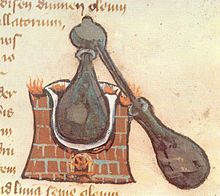 |
| http://www.asiagilsonite.com/?page=specification |
Asphalt (commonly misidentified as tar, as in The La Brea Tar Pits, or as pitch) occurs in nature in both pool and rock form (modern asphalt is usually a crude oil byproduct). Rock asphalt has various percentages of tar mixed with sandstone or limestone. With modern machinery, this rock can be crushed and used for road surface with little to no processing. Asphalt's exposure at the surface has allowed the more volatile chemicals to evaporate, making it a poor fuel source. The first written evidence of its use is by the Babylonians, circa 625 BC. It was mixed with burned brick to pave Procession Street, leading from the palace to the north wall of Babylon (possibly also used as a building material). Asphalt was used by the Egyptians in the process of embalming their mummies. It was later used by the Romans to seal their baths, reservoirs, and aqueducts. Tar has also been used as an adhesive, as well as a way to waterproof clothing and containers.
Crude oil rises naturally to the surface in some places as seeps (which can be drilled and pumped for higher rates of removal). This oil retains its volatility allowing it to be useful for such things as fueling lamps and making fire arrows (Persians 480BC). The Chinese were first reported to be drilling for oil (using bamboo) around 347 AD, but have apparently been doing it for over 2,000 years (even piping in a natural gas/air mix for illumination). These early drilling discoveries resulted from attempts to find briny water for salt production. Oil has been used for medicinal purposes (gout, mange, diphtheria, cramps, colds, coughs, burns, cuts, and who knows what else) in various regions throughout the world, though most references seem to refer to the "white" variety (possibly kerosene). Oil was reportedly already a staple of trade in 10th Century Baku (modern day Azerbaijan). Natural oil springs that were later exploited north of Baghdad, called "eternal flames," had been burning since at least 600BC.
 |
| http://en.wikipedia.org/wiki/Alembic |
The many outstanding characteristics of petroleum made it a desirable commodity long before we learned how to turn it into plastic or conceived of internal combustion. Sources have been found on every continent, though some more plentiful than others. It has been utilized in construction, medicine, illumination, and warfare since the days of old. In its various forms it may be known for durability or volatility. It has been a source of wealth for more than a thousand years. The presence of a material such as this would be a game changer on any world. Be careful to whom you offer it in yours.
Note: The "tar" and "pitch" traditionally produced in Medieval Europe (for waterproofing and shipbuilding) was a material derived from pine trees as a byproduct of making charcoal and had a sweet musky scent.
Sources
Where oil comes from - https://www.youtube.com/watch?v=0PrSZMOCnWU&list=UUje_eGYF31gCVmmNj-Njy1A&index=6&feature=plcp&hd=1
Oil Wiki - http://en.wikipedia.org/wiki/Petroleum
Petroleum Geology - http://www.petroleumgeology.org/geologyandpetroleum.cfm
Asphalt History - http://www.asphaltpavement.org/index.php?option=com_content&view=article&id=21:history-of-asphalt&catid=196:uncategorised&Itemid=57#
Rock Asphalt - http://geology.about.com/od/rocks/ig/sedrockindex/rocpicasphalt.htm
Timeline of Uses - http://www.geohelp.net/world.html
Chinese Oil - http://www.historylines.net/history/chinese/oil_well.html
General History Summary - http://dnr.louisiana.gov/assets/TAD/education/BGBB/2/ancient_use.html
General History Summary - http://grandemotte.wordpress.com/peak-oil-4-exploration-history/
Kerosene Wiki - http://en.wikipedia.org/wiki/Kerosene
Medieval Islam Weaponizing (fantastic) - http://www.saudiaramcoworld.com/issue/199501/the.oil.weapons.htm
No comments:
Post a Comment